Stone-shocked
I’d heard about Stone Mountain. On my last trip to Atlanta 6 years ago. More in passing conversation, as an inside joke that I didn’t get. “Some people are going up to Stone Mountain tomorrow.â€Â “You going?â€Â “Yeah right.â€
“What’s Stone Mountain?â€Â I’d asked blindly.
A few people stared at me while someone answered flatly, “It’s like a Confederate Mount Rushmore.â€
I’d been intrigued ever since. That intrigue was only heightened by the episode of “Undercover Boss†that included a stint at the amusement park that surrounds the landmark, focusing on the WWII duck boats that shuttled visitors through part of the park.
So when Kelly, the friend who had instigated the Peru trek we were about to embark upon, handed me her keys and a map and told me to head out to Stone Mountain for a bit of hiking, I was totally game. “See what time the laser show is,†was her only instruction.
She’d bought the season pass to the park as part of her preparation for Peru. Stone Mountain, with its strange geography was a good place to get some uphill trekking in. But an Achilles injury had kept her from using the pass fully, so she was eager to have me take advantage of it.
I studied the map, and headed out. The mountain was about 30 minutes away. As I drove, I sang to the radio, watching a bubble in the Earth’s surface growing.
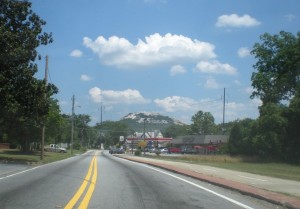
The further I drove out of the suburb of Decatur, the bigger and louder the trucks became, and the further from home I felt. I know it sounds cliché, but it was my experience. At about 40 minutes, I looked in my rear-view mirror and saw the mountain. Crap. I’d sung myself right past the place. I turned around and hoped I’d be able to use the bubble to navigate myself back. Even so, I wasn’t completely sure which turn to take to get to which gate. My usual half-lost-but-okay-with-that self was fading a bit as the monster trucks seemed to crowd nearer to my little Acura at stoplights.
I found my way back to the village of Stone Mountain, and wound through the streets toward the stone. After a couple of wrong turns within the park, I located the right parking lot and a sign to the trailhead.
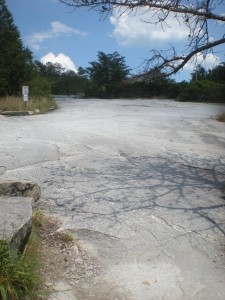
Which wasn’t much of a trailhead. Just a stone face. I paused for a moment to see where other people were going. And they were going up. Straight up the stone. I followed them, interested in a new adventure, and struck by the really strange geology of the place.
Green scrub reached out, sending fingers of scratchy brush along the stone face. Trees grappled with the ground, finding a hold. Great swaths of smooth stone were exposed from the thunderstorms that hit the place regularly.
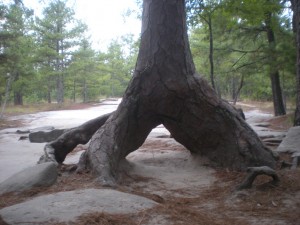
Bobbing along through the scrub, I looked around, side-to-side, up and down, taking it all in. This wasn’t so bad. Strange and all, but still… And then, about 100 yards in, I froze a little inside.
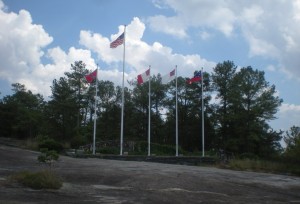
Yes, I know the Confederate battle flag is a symbol of independence; of rebellion. But where I come from, it means more than that. For a lesbian alone in the woods, it means quite a lot. My ex-girlfriend of 4 years was from the south. From Alabama. And she’d tried to explain the flag’s significance. I’d never really understood completely. It was like trying to understand the utility of the pink triangle.  I was curious, but uncomfortable. I looked over at the display of flags, considered stopping, and then sped up, happy to move out of the clearing, and wondering what else I might find.
What I found was a moonscape. It is, quite literally, like nothing else I’ve ever seen. The “mountain†seemed to be dropped out of the sky, or left behind by an incomprehensively large glacier.
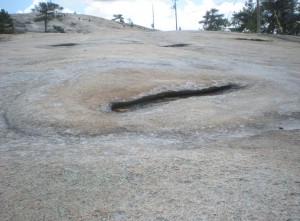
Pitted and strange it stood, as people, like ants, climbed its face and carved their loyalties into its side.
I climbed with them, wondering if they could sense my unease. I climbed with trail runners, and German tourists. I climbed with families, black and white, who seemed either oblivious or unconcerned with the blatant history of the place. I wondered, blithely, whether I’d take my children to an anti-gay monument to go hiking.
The top of the mountain is large, and flatish, the edges dropping dramatically to the greenbelt below. I did a circuit, looking over the side, wondering where the Confederate generals were carved. Until I found what I was pretty sure was the place, based on the grand, grassy viewing area below.
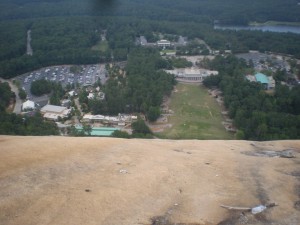
And the gondola platform.
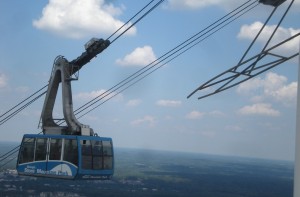
With the gondola shuttling people from the ground to the top of the stone. For what, I’m not sure. I’ve ridden the tram in Portland just to say I rode it, and to see the views on the way to Oregon Health Sciences University. Maybe it’s kind of like that. I’m not sure. Or like riding a ski-lift to the top, in order to see the view. And I have to say that the views from the top were spectacular. It was as though I was looking down on the city from a meteor. It’s possible that I was.
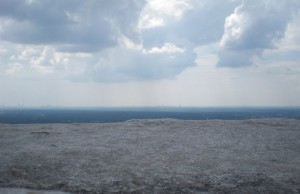
The place was strange.
Have I mentioned that? The geology alone was strange enough. Smooth sections, then great pits, then strange bumps adorned the surface.
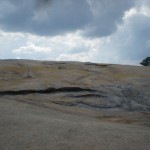
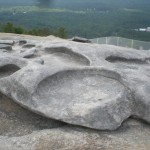
Normally, I’d find a quiet spot, sit, and commune with nature for a bit. But I felt unsettled in this place. It reminded me of the feelings I’ve had when I’ve visited prisons. As a 6th grader on a field trip, or an attorney for the state. There’s a violence in the air. A stripping away of something. A deep unrest sat about the rock, and I couldn’t tell whether it was the people, the weather, or the place itself, churning with a displeasure. I watched the skies change, and the vultures circle. And then I made a break for it.
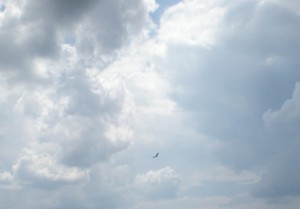
As I jogged down the stone face, the rain started, dotting the thirsty surface, and making everything incredibly slick. Only once did my shoes fail. On the steepest part, I slipped backwards, arms flailing out to grasp the handrails that jutted from the steep ground, waiting to catch unwary visitors.
When I reached the flags again, I decided to stop. The rain was coming down lightly, and my curiosity was even greater than before. I carefully read the placards in front of each flag, considering the combined history. The frustrated history of mistaken identity: Stars & Bars was changed to the battle flag, so as not to be mistaken with Stars & Stripes in a fight. The battle flag incorporated into the white field of the second national flag, which had to have a vertical, red bar added later, so as not to be mistaken for a flag of truce.
That’s a rough history for a movement. Seems a little confusing. I tried to commit it to memory, as I walked the last bit of the trail to the parking lot, past the African-American families headed up the mountain with beach chairs under their arms.
Before I left the park, I wanted to see the carving. I know very little about the Civil War, other than I was taught that it was about slavery, and my ex was taught that it was about trade embargos. I couldn’t tell you who the heroes of the war were, or where the important battles happened. But I still wanted to see the generals carved into the side of the stone.
I drove around the edge of the park until I saw a sign for the plantation and the “memorial lawn.â€Â It sounded promising. I walked past the boarding area for the gondola, where Star Wars music was being pumped like IV fluid to the excited families waiting to fly to the top, through a whitewashed colonial-style building that vomited air-conditioning into the Atlanta heat, and out onto a viewing area.
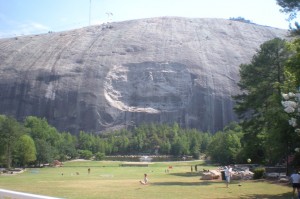
Stonewall Jackson, Robert E. Lee and Jefferson Davis rode across the face of the rock, their horses given equal billing on the informational signs.
I stood there, battling my fight or flight response. Fascinated. Petrified. Now, I’d like to make it clear that I’m an intelligent person. That I’m fairly rational. That I have deep interest in things that are different from my experience. I often seek these situations out, ready to confront my unease. But here, the unbelievable discord of the place crept into my cells. It still does when I think back on it. And I couldn’t find a way through it.
So I tried the nature path. The path led past flags of the confederate states. Scarcely little information was provided. Too bad, really. I was happy to learn more. But I’d have to do it online. I walked down to the front of the lawn and back around. I saw the scenic railroad cars filled with tourists. I saw the high-ropes course and the recreated “Crossroads†town. I saw the white families playing volleyball in the shadow of the mountain, and the young black men wearing “Stone Mountain†polo shirt uniforms as they staffed the attractions.
And then I left. Uncomfortable, but curious. And excited to talk with my Atlanta friends about what all I’d observed – sure I was missing some major dynamics that would help it all make sense. (In fact, as I write this, I’m sure there are people who will be willing to tell me how I got this all wrong, and why, exactly, this is understandable. And probably how racially and socially insensitive I am. That’s great. I’d like to know.)
Only, when I got back to the house, my Atlanta friends looked at me like I was a small child, unable to really understand. “Am I missing something?â€Â I asked, after describing the black workers and picnicking families.
“Hmmm,†is about the extent of what I got in response.
I tried again a few days later with another friend who had grown up there. “We’re thinking of going to the laser show at Stone Mountain. Want to join?â€Â The Stone Mountain laser light show is legend. Confederate glory lasered on to the face of the mountain and set to classic rock. According to the website, there also seemed to be some kind of tribute to Elvis. My friend was not interested.
“It’s just a bunch of rednecks,†was her response. She didn’t go much beyond that when I probed further. I didn’t find that response especially helpful.
It wasn’t until I posted about my experience on facebook that I got anything more. A law-school classmate who had grown up in Atlanta, and happened to be African-American, responded to my “am I missing something here?†post.
“No, not missing anything. That kind of crap is just so engrained there that people don’t notice it … It’s still very much the old south for much of the population mentally. Took me leaving to realize how truly creepy the laser show is (or even just the carving by itself). Like I said, issues.â€
Indeed. When I googled Stone Mountain, I found out that the man who carved Mount Rushmore had originally been involved in the carving of Stone Mountain. Interesting enough. I also found out that the KKK had re-org meetings on the top of the place. You know right around where the tram lets people off to visit the gift shop. And the snack shop.   I think maybe society has some issues. Or maybe I have some issues. I don’t know. But, for the first time, I found myself unable to understand. Unable to come up with some storyline that made sense of what I was seeing. But I guess it made sense to the German tourists. I don’t know. I just don’t know.



3 comments
Hmmmmmm……..something to ponder.
Had a neighbor that was from Stone Mountain. That explains alot!
OK…so I have been to Atlanta no less than 75 times and spent probably 250 days/nights there on business and some pleasure. Never have I seen pictures or heard descriptive dialog such as you have put together here. Keep up the fantastic writing Kristin….